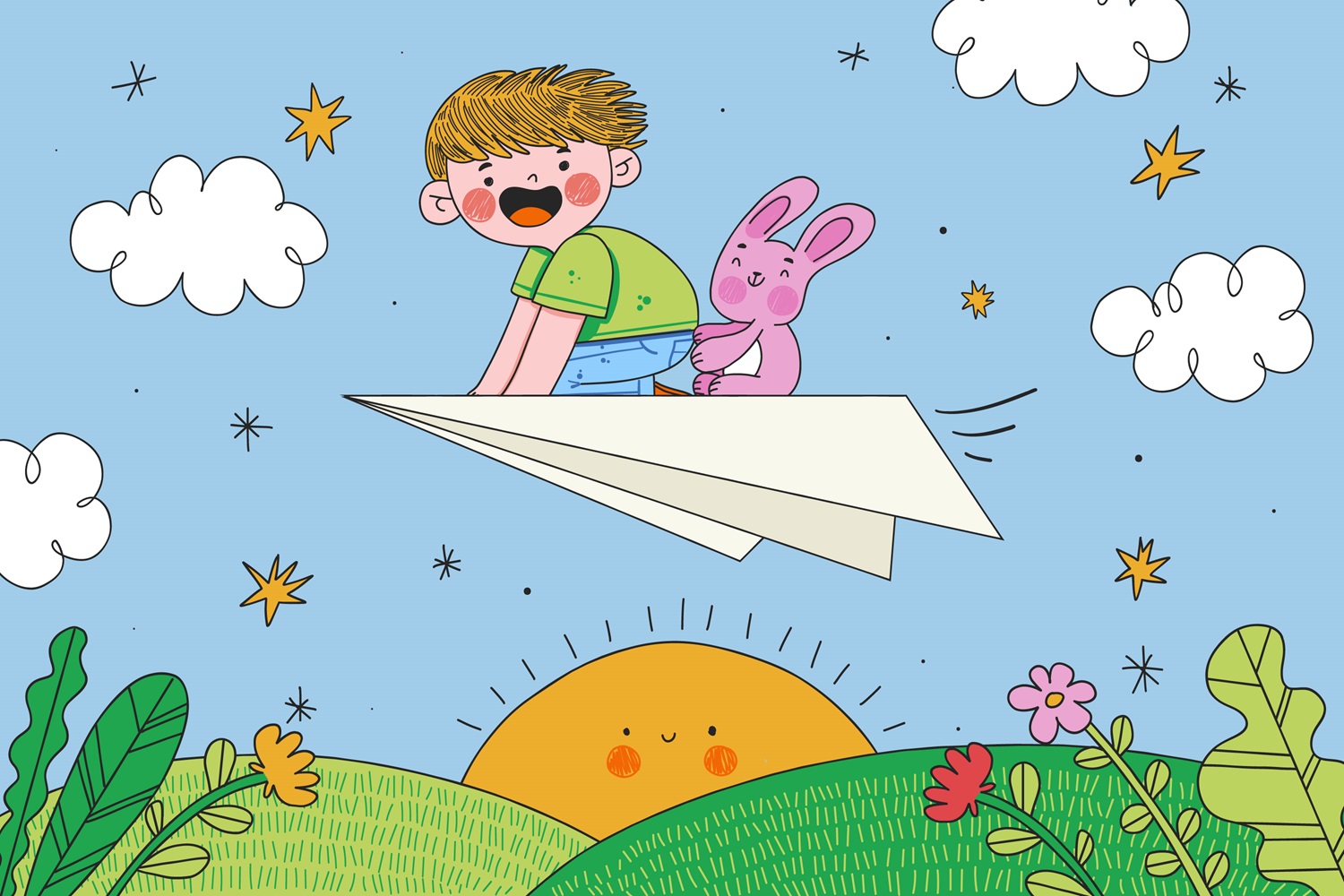
Most children are fascinated by flying objects, especially airplanes. The dream of soaring through the sky like a bird captures the imagination of children. At the K-Rockets STEM programs for children, one of the most popular activities is building paper airplanes. Paper airplanes, although simple in design, provide a timeless STEM activity for kids. Building and flying paper airplanes not only engages kids with hours of entertainment but also introduces them to fundamental principles of aerodynamics. In this blog post, we will explore the science behind a paper airplane design, and the educational benefits. Before we dive into the hands-on project of making paper airplanes, it is important to understand the basic principles of aerodynamics that make these simple works of art fly.
Lift and Gravity
The key to any successful flight is the balance between lift and gravity. Lift, the force that keeps an airplane in the air, is generated by the wings. Gravitational force or gravity, just like everything else on Earth, pulls the airplane downward. When a paper airplane is thrown, the wings generate lift, counteracting the force of gravity and allowing the airplane to stay airborne – even if it is only for a few moments.
Thrust and Drag
Thrust is the forward force that propels the paper airplane through the air. Thrust comes from the initial throw or launch. Drag, the resistance against forward motion, slows the airplane down. A well-designed paper airplane minimizes drag to maximize distance and flight time.
Center of Gravity
Achieving balance is critical for an airplane, or in our case, paper airplane’s stability. The center of gravity is the point on the airplane where its weight is concentrated. For a good design, it must be aligned with the center of lift to prevent the airplane from tumbling in mid-air. Understanding this balance is key to crafting airplanes that fly smoothly.
The Joy of Crafting and Launching
Now that we’ve touched on the physics behind paper airplanes, let’s explore the joy of crafting and launching these miniature marvels. The design below is one of the many that are taught to the children during the K-Rockets STEM programs.

Step-by-Step Guide to Crafting a Classic Paper Airplane
- Select a Paper:
- Choose a standard sheet of printer paper for your first attempt. As you become more experienced, experiment with different paper weights and sizes.
- Fold in Half:
- Fold the paper in half lengthwise, creating a center crease.
- Unfold and Fold Edges:
- Unfold the paper and fold the top edges down to meet the center crease. This creates an isosceles triangle with the base at the bottom.
- Fold Triangle Down:
- Fold the entire triangle down along the center crease, creating a smaller triangle with a straight base.
- Form the Wings:
- Fold both top corners of the triangle down to meet the bottom edge, creating the wings of the airplane.
- Final Fold:
- Fold the entire airplane in half along the original center crease, concealing the wings within. This final fold also determines the position of the center of gravity.
Tips for Launching
- Throwing Technique:
- Hold the airplane at the midpoint of its body and launch it at a slight upward angle.
- Experiment with different throwing techniques to achieve various flight patterns.
- Adjustments for Flight:
- If the airplane consistently nosedives or climbs rapidly, make small adjustments to the wings or tail to modify its flight characteristics.
- Experiment with Designs:
- Explore different folding techniques and designs to see how they impact the airplane’s performance. For example, try adding winglets or modifying the wing shape.

Educational Benefits of Paper Airplane Fun
The joy of crafting and launching paper airplanes extends beyond basic entertainment; it offers valuable educational benefits for kids. K-Rockets STEM programs for children emphasize project based learning, be it Math, Coding or Robotics, hands-on experience is critical for learning quickly and effectively.
1. Hands-On Learning
Paper airplanes provide a hands-on introduction to fundamental concepts in physics and engineering. Kids can see the immediate impact of their design choices on the airplane’s flight performance.
2. Introduction to Aerodynamics
Crafting and launching paper airplanes is an informal yet effective way to introduce kids to the basics of aerodynamics. Concepts such as lift, gravity, thrust, and drag become tangible as kids experiment with different designs.
3. Problem-Solving Skills
Adjusting a paper airplane’s design to achieve better flight characteristics requires problem-solving skills. Kids learn to identify issues, make hypotheses, and test their solutions – a valuable process applicable to many areas of life.
4. Creativity and Design Thinking
Experimenting with various paper airplane designs encourages creativity and fosters an understanding of design thinking. Kids can express themselves through the customization of their creations while learning about form and function.
5. Encourages Scientific Inquiry
Launching a paper airplane invites curiosity. Why does it fly in a certain way? What happens if we change the wing shape? These questions spark scientific inquiry and a natural desire to explore and understand the world around them.
Conclusion
Curiosity of flying objects is simplified with this simple act of crafting and launching paper airplanes. It opens up a gateway to the fascinating world of STEM subjects such as physics and engineering for children at a young age. Beyond the immediate thrill of watching an airplane soar through the air, kids gain hands-on experience with scientific concepts, problem-solving skills, and the joy of creative expression. So, the next time you reach for a sheet of paper, remember that you’re not just folding an airplane – you’re unfolding a world of educational possibilities for the young aviators. Happy flying!


